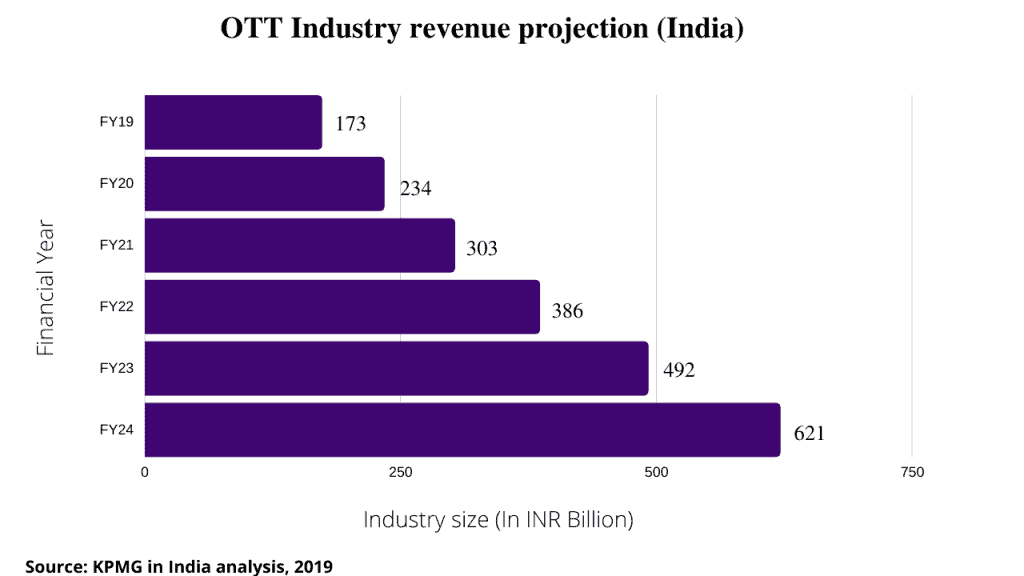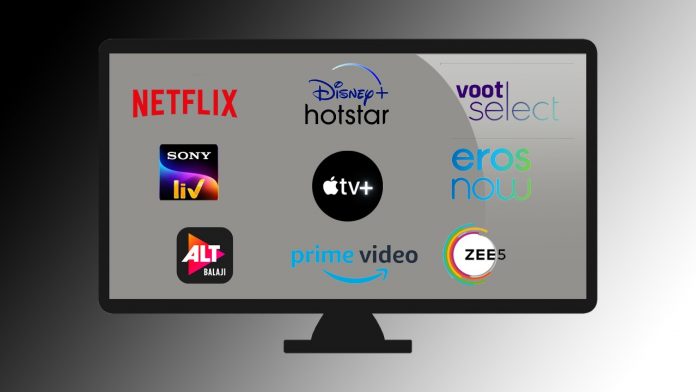Drama is commonplace, whether it be OTT (over the top) or moderate. However much we want a life free of drama, it is without question that our way of life would be pretty bland otherwise. At least, without the one that doesn’t involve us!
In fact, we love drama so much that we even love to watch it as it unfolds on the screen. (Big or small, have your pick.) Take, for example, Ozark or The Crown. *runs off to get some popcorn*
While drama may be an integral part and parcel of life (real and virtual), are you not curious to know how OTT debuted on the Internet? They may feel like overnight sensations, but in reality, all of them are a labour of love and perseverance.
By them, I mean Netflix, Amazon Prime Video, Disney+Hotstar, etc. All the streaming platforms, which sometimes is the very air that millennials breathe, adapted to their present-day versions with the rapidly changing media space. (Binge-watching, anyone?)
And in times of corona; while Gen Z may have been born into it, many of the boomers and Gen X are slowly but surely getting used to the new means of watching media. Especially with the entire family staying home and the lack of television sets available per person in the household.
Mobile phones, tablets, and laptops have become the new televisions. We’ve gathered some interesting facts about the inception of the streaming services and how they came to be the giants that they are today. ‘Loved and lusted’ after by all, if we may.
What is the meaning of OTT?
OTT, short for ‘over-the-top’, is nowadays a term synonymous with OTT streaming service offered directly to viewers via the Internet. It bypasses the traditional means of distribution of such content via the cable, broadcast, and satellite television platforms, or the companies that traditionally act as a controller of these contents.
Moving on to the fascinating side of things, OTT still means over the top. As in excessive or exaggerated. As simple as that. So, please use OTT platforms while chattering about Netflix, Prime Video, etc and don’t get misled by the headline.
But, OTT also means a ‘skinny’ television service that offered access to live streams of linear speciality channels. (Think back to those days of dancing to the tune of MTV, or that frivolous item you bought after the Home Shopping Network convinced you of its need in your life. By the way, what did you buy?)
With reference to food, just think of the skinny bundles in terms of wanting to eat deep-fried crisps but the one making it is stingy with the oil. (The skinny bundles do have a fancy name in à la carte pay television, very French of them.)
But seriously, over the top of what, the television perhaps.
Would you believe Netflix started in 1997?
Yes, you read that right. Right!?! Time to evaluate whether you are incompatible or if Netflix is still your true love. Seeing that it didn’t really start off as a subscription-based streaming service of jaw-dropping series and films that it is famous for now.
Founded on August 29, 1997, by Reed Hastings and Marc Randolph in California; Netflix started off as a DVD sales and rental by mail. The sales part of the business was abandoned within a year.
Within five months of DVD being introduced in the United States and inspired by Amazon which was still at a nascent stage, Hastings and Randolph came up with the idea of getting DVDs home delivered was rather rad. Nothing beats the comfort of getting something without stepping out of the house, which you don’t have to buy, and without a deadline to return it.
It was in 1999, two years later, that Netflix started offering a monthly online subscription service through the internet. Nope, still not reached the streaming part yet. But that is how they grew from strength-to-strength, continuously changing and challenging themselves.
Albeit it was a rough ride, what with the offer of being acquired by Blockbuster (then a major competition and provider of home and video game rental services through brick-and-mortar stores) to experiencing the burst of the dot-com bubble. But, Netflix emerged stronger than ever with the rising popularity of DVD players.
Netflix streamed its way into your heart in …
… 2007 when it first started offering its subscribers the option to stream some of its movies and television shows directly to their homes through the internet. But the breakthrough happened in 2013 with the Netflix Original web series, House of Cards, which went on to run for a record six seasons – winning accolades and awards for itself and for the platform it was streamed on.
And as they say, there was no looking back for Netflix as it proceeded with its plan for world domination. From streaming media in two countries in 2010, it is now available worldwide except in two countries since 2017. But, was it the first streaming platform to enter India?
When The Viral Fever gripped India!
In 2010, when Netflix had just started dipping its toes in international waters, the home-grown TVF Media Labs had felt the need for an online platform in order to reach out to the younger generation in the country who seldom depended on the television for entertainment purposes.
Starting with sketch comedy shows on its YouTube channel, The Viral Fever became the first Indian platform to create original digital content. Permanent Roommates became India’s first web series which debuted in 2014 and soon became the second most-viewed web series worldwide.
Since then it has given an award-winning web series, TVF Tripling, and continues to entertain us with a host of delightful shows as well as relevant videos (like the recent Corona Conversation with Dad).
One can just about imagine TVF having a laugh at our expense today. Had they thought that a day would come in the future when their strategic branding would become the go-to adjective that Indians would embrace? After all, everything does become viral in this one billion-plus populated country of ours.
Who all joined the OTT bandwagon in India?
A number of OTT platforms entered the Indian scene in 2010 where they showcased content already being aired on national television, like BIGFlix, Ditto TV, and SonyLiv. Hotstar (known as Disney+Hotstar in India) followed in 2015, which is the most subscribed OTT platform in India at present. Netflix entered the fray in 2016.
Netflix seemed to have opened the floodgates for the OTT media as a slew of platforms soon entered the Indian industry, both global players and home-grown ones. From Amazon Prime Video to Zee5, ALTBalaji, Voot Select, and MX Player; there is serious competition now to churn out original content. Even regional content OTT platforms (like Hoichoi and Sun NXT) have set foot in the competition to cash in on the moolah.
While TVF started it all with Permanent Roommates, what has followed since then is a wave of Indian original content. From Zee5’s Churails and Abhay to ALTBalaji’s Code M and The Test Case to Hotstar Special’s Criminal Justice and Special OPS to Voot Select’s Time Out and It’s Not That Simple to MX Player’s Aashram and Dangerous, it doesn’t end there.
Now, the global platforms like Netflix and Amazon have not only made their content available for the Indian audiences but have also started making original and targeted content for consumption by the masses. The popularity of Netflix’s Sacred Games and Ghoul, and Amazon Prime Video’s Mirzapur and Made in Heaven are excellent examples of the streaming giants fighting for a piece of the Indian OTT pie, and also succeeding to a large extent.
What do the numbers say?
The latest EY Digital Consumer Survey reveals that people staying home has been good for online content streaming and not only has viewership surged but paid OTT subscriptions have been highly preferred with 60% of the respondents in India opting for it.
KPMG’s recently released media and entertainment sector perspective in the Covid-19 crisis highlights the low impact of the pandemic on the OTT segment in India. The lockdown has further provided a boost to the industry.
According to KPMG in India’s Media and Entertainment Report 2019, the Indian OTT industry’s overall size was ₹17,300 crores in fiscal 2019. With a compounded annual growth rate of 29.1 per cent, it is projected to reach ₹62,100 crores by the end of fiscal 2024.

With a compounded annual growth rate of 38.5 per cent over the last five years, the digital industry – which includes the video and audio subscription revenues – is set for the highest growth in the Indian media and entertainment industry.
But I want new shows!
With growing investment in original content, things are looking bigger and better for the OTT platforms while for consumers the prospect of new content-driven web series and films is brighter.
Netflix Chairman and CEO Reed Hastings while speaking to the media in December 2019 said that the company is looking to invest ₹3,000 crores for original content in India. Close on its heels came Amazon chief Jeff Bezos’ plans to double their investment in original Indian content this year.
Zee5 claims to have witnessed a two times growth in subscription revenue due to the investments it made in creating original content, with over 100 original web series on its platform.
Past, present and future
Remember your high school days? When you used to download movies overnight. Or rather download a movie, only one, which took approximately six to eight hours before you could finally watch it. From those days about a decade back to the present, when you can watch any series/film at the drop of a hat (or to be more terminologically accurate, at the click of a button).
The OTT industry looks all set for a revolution since all the OTT platforms not only provide premium and niche content but also serve as a catch-up for their respective television counterparts. You don’t have to remember the telecast time any more nor miss out on your favourite series or films.
And with the likes of Reliance Jio and Tata Sky coming out with their own rapid broadband services with a promise to reach every corner of the nation and Google investing 10 billion in India’s digital future, it’s only going to get better!
Enjoy streaming your favourite films and binge-watch the web series you want to anytime, from anywhere! As long as you have a smart device and an internet connection to go with it.
Also read: How expensive is Disney+ Hotstar compared to other platforms in India?

